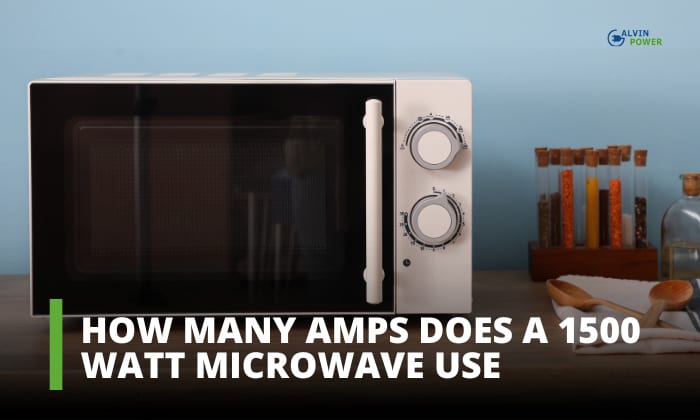How many amps does a 1500 watt microwave use? A 1500-watt microwave will draw around 12.5 amps when operating on a typical 120-volt household circuit in the United States.
However, the exact current draw can vary based on the microwave’s efficiency and voltage supplied. Microwaves require high amperage to generate the strong microwave energy that cooks food quickly.
Still, this level of power comes at a cost – for one, it could lead to a scenario where a high electrical current draw can trip breakers if not used properly.
Typical Amp Draw of Microwaves
Microwaves are high-wattage appliances. Here’s a look at the amperage required for common models:
| Microwave Power | Amps at 120V | Amps at 240V |
| 600W | 5A | 2.5A |
| 700W | 5.8A | 2.9A |
| 800W | 6.7A | 3.3A |
| 900W | 7.5A | 3.75A |
| 1000W | 8.3A | 4.2A |
| 1200W | 10A | 5A |
| 1500W | 12.5A | 6.25A |
As you can see, microwave amp draw rises rapidly with higher wattages. A 1500-watt microwave oven requires significantly more current than a 700W model.
One Reddit user discussed the importance of considering the wattage of a microwave before purchasing, explaining that low-wattage microwaves (600-700 watts) may not cook food as effectively as higher-wattage microwaves (1000-1200 watts).
The user further suggests that a 1500-watt microwave would likely be even more efficient and powerful due to the higher amperage usage.
One Quora user shared results from testing their own microwave, which was rated for 1250 watts. At full power, it drew over 17 amps and 2000 watts.
This discrepancy can be attributed to factors such as the efficiency of the microwave, the voltage supplied, and the load being cooked.
Moreover, this only reinforces that real-world current draws can exceed nameplate ratings, especially for high-wattage microwaves.
Factors Affecting Draw
These are more or less the factors that affect the current draw of a microwave:
- Voltage – Higher voltage reduces the amps needed. For instance, a microwave that uses 1000 watts would require 8.3 amps at 120 volts, but if your home has a 240-volt power source, the amperage will be halved to 4.2 amps.
- Cooking Load – The amount of food being cooked can also affect the power draw. Larger quantities of food require more energy to heat, which can increase the current draw.
- Atmospheric Conditions – If you live in an area with high humidity, it will take more energy to heat the food, thus increasing the power consumption
Take note that the table above only provides estimates. Your specific microwave amperage may be slightly higher or lower.
Another Reddit user asked about the optimal wattage for a microwave, with the consensus suggesting that higher-wattage microwaves (around 1000 watts) are generally more effective. This again implies that a 1500-watt microwave would be quite powerful and draw a significant number of amps.
Calculating Amperage
You can calculate the amp draw of any appliance using this simple formula:
\[ \text{Amps} = \frac{\text{Watts}}{\text{Volts}} \]
For a 1500-watt microwave on a 120-volt circuit, we’ll arrive at the following equation:
\[ \frac{1500 \, \text{Watts}}{120 \, \text{Volts}} = 12.5 \, \text{Amps} \]
So, theoretically, a 1500W microwave will draw around 12.5 amps. However, there are a few caveats:
- Input wattage may exceed the listed cooking wattage
- Actual voltage may not be exactly 120V
- Other factors can alter the efficiency
Therefore, it’s best to consult an electrician to install a high-wattage microwave on your home circuit. They can help determine the exact electrical requirements.
Conclusion
A 1500W microwave provides very fast cooking times. That much is certain. However, all that microwave energy comes at the cost of a high current draw. In fact, 12.5 amp is how many amps does a 1500 watt microwave use.
Always take care to properly install the microwave on a circuit able to handle the load. Consulting an electrician is advisable to be safe. While the 1500W model sounds appealing, a lower wattage option may be a more practical choice for homeowners.

I am Andrew Wright. With 8 years of experience designing, installing, and maintaining electrical power systems. I love my job, and I have always wanted to offer others the necessary help so they can take care of their houses.



